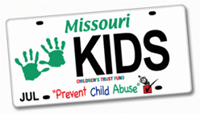As summer temperatures heat up in Missouri, the Children’s Trust Fund (CTF) reminds all parents and caretakers to never leave a child unattended in or around a vehicle. The interior of a vehicle can heat up to temperatures well over 100 degrees in just a few short minutes. But regardless of the temperature, children should NEVER be left alone in a vehicle because of other dangers and risks. A child left unattended in a vehicle even for a short time is in danger of dehydration, overheating, hyperthermia, injury, abduction and even death.
The National Highway Traffic Safety Administration (NHTSA) recently released its first-ever “Not-in-Traffic Surveillance 2007 – Children” confirming that preventable deaths and injuries associated with motor vehicles happen with regularity every year, not only on public roadways, but on private driveways and in parking lots. The safety agency report estimates that thousands of tragic and life-altering incidents occurred in 2007 due to children being left alone in hot vehicles, being backed over, or powerful automatic vehicle windows closing on necks and limbs of car occupants.
To help spread this critical safety message, CTF offers several public education materials from our ‘Not Even For A Minute‘ Campaign (NEFAM). These are available at no cost in hard copy and download (pdf) and include a poster and rack card complete with helpful tips and reminders. The NEFAM Campaign also includes television and radio public service announcments (PSAs):
KidsAndCars, a national organization that addresses safety issues of children in and around vehicles, provides several helpful tips and reminders to parents and caregivers.
- Never leave a child alone in a vehicle and teach your children to never play in, around or behind a vehicle.
- Put something you’ll need like your cell phone, handbag, employee ID, lunch or brief case, etc., on the floor board in the back seat. Get in the habit of always opening the back door of your vehicle every time you reach your destination to make sure no child has been left behind. “Look before you lock” will soon become a habit.
- Keep a large teddy bear in the child’s car seat when it’s not occupied. When the child is placed in the seat, put the teddy bear in the front passenger seat. It’s a visual reminder that anytime the teddy bear is up front you know the child is in the back seat in a child safety seat.
- Make arrangements with your child’s day care center or babysitter that you will always call them if your child will not be there on a particular day as scheduled. This is common courtesy and sets a good example that everyone who is involved in the care of your child is informed of their whereabouts on a daily basis. Ask them to phone you if your child doesn’t show up when expected. Many children’s lives could have been saved with a telephone call from a concerned child care provider. Give child care providers all your telephone numbers, including that of an extra family member or friend, so they can always confirm the whereabouts of your child.
- Use drive-thru services when available. (restaurants, banks, pharmacies, dry cleaners, etc.) Use your debit or credit card to pay for gas at the pump.
- If you see a child alone in a vehicle, get involved. If they are hot or seem sick, get them out as quickly as possible. Call 911 or your local emergency number immediately.
- Keep vehicles locked at all times; even in the garage or driveway and always set your parking brake. Keys and/or remote openers should never be left within reach of children.
- Make sure all child passengers have left the vehicle after it is parked. Hold child’s hand firmly when leaving the vehicle.
- Know where your kids are. When a child is missing, check vehicles and car trunks immediately.
- Walk around and behind a vehicle prior to moving it. Make children move away from your vehicle to a place where they are in full view before moving the car and know that another adult is properly supervising children before moving your vehicle. Keep toys and other sports equipment off the driveway.
- Teach children that “parked” vehicles might move. Let them know that they can see the vehicle; but the driver might not be able to see them.
- Be especially careful about keeping children safe in and around cars during busy times, schedule changes and periods of crisis or holidays
- Consider installing cross view mirrors, audible collision detectors, rear view video camera and/or some type of back up detection device.
- Measure the size of your blind zone (area) behind the vehicle(s) you drive. A 5-foot-1-inch driver in a pickup truck can have a rear blind zone of approximately 8 feet wide by 50 feet long. Be aware that steep inclines and large SUV’s, vans and trucks add to the difficulty of seeing behind a vehicle.
- Homeowners should trim landscaping around the driveway to ensure they can see the sidewalk, street and pedestrians clearly when backing out of their driveway. Pedestrians also need to be able to see a vehicle pulling out of the driveway.
Resources & Articles:




